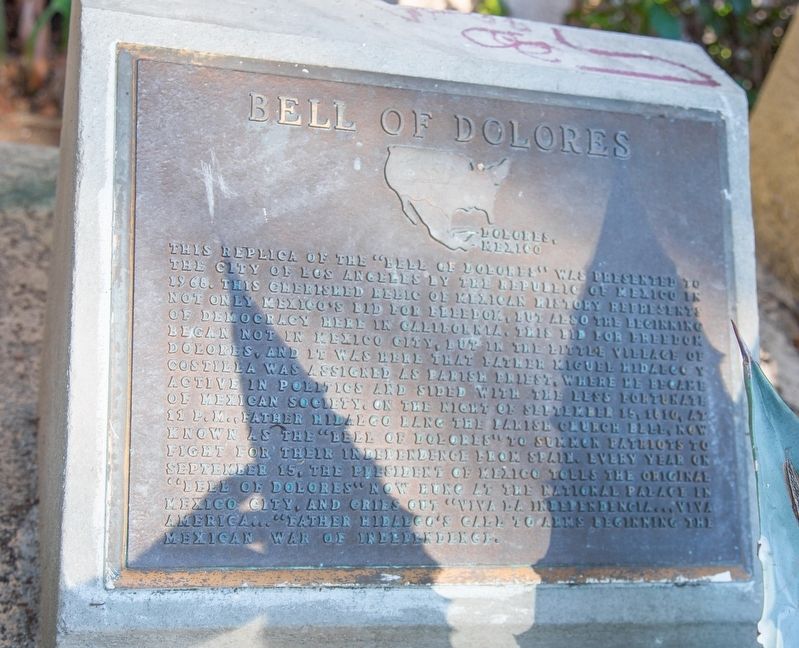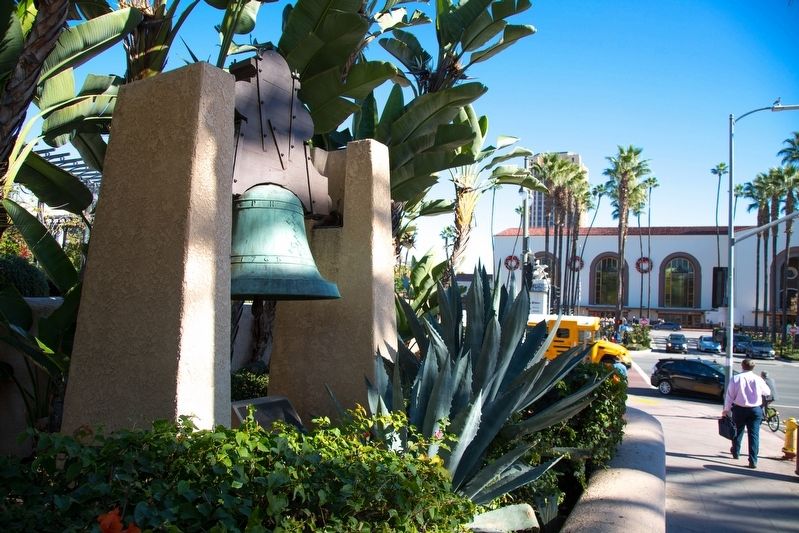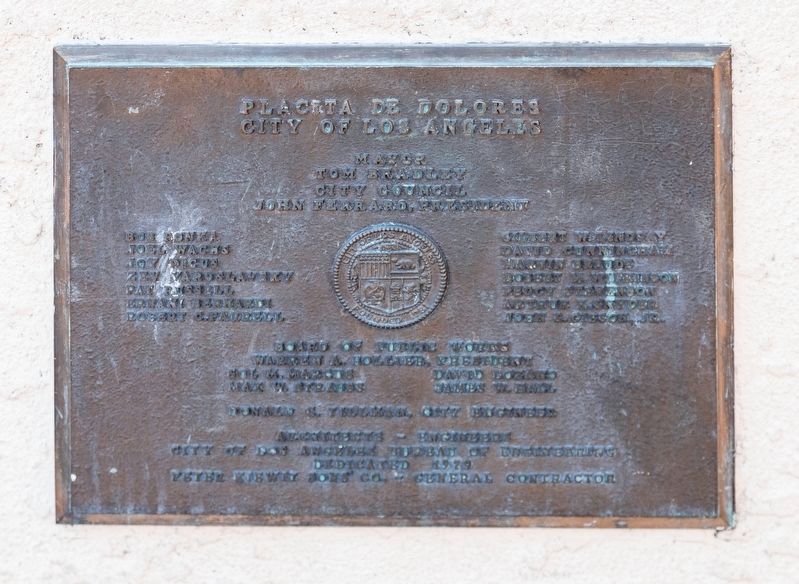Downtown Los Angeles in Los Angeles County, California — The American West (Pacific Coastal)
Bell of Dolores
On the night of September 15, 1810, at 11 p.m., Father Hidalgo rang the parish church bell now known as the “Bell of Dolores” to summon patriots to fight for their independence from Spain. Every year on September 15, the President of Mexico tolls the original “Bell of Dolores” now hung at the National Palace in Mexico City, and cries out “Viva la Independencia! ... Viva America!”, father Hidalgo’s call to arms that began the Mexican War of Independence.
Topics and series. This historical marker is listed in these topic lists: Patriots & Patriotism • Wars, Non-US. In addition, it is included in the Historic Bells series list. A significant historical date for this entry is September 15, 1810.
Location. 34° 3.395′ N, 118° 14.267′ W. Marker is in Los Angeles, California, in Los Angeles County. It is in Downtown Los Angeles. Marker is at the intersection of Los Angeles Street and North Alameda Street, on the right when traveling west on Los Angeles Street. It is on the edge of the Placita de Dolores, but facing Los Angeles Street, near the Antonio Aguilar statue. Touch for map. Marker is in this post office area: Los Angeles CA 90012, United States of America. Touch for directions.
Other nearby markers. At least 8 other markers are within walking distance of this marker. Union Station (a few steps from this marker); Antonio Aguilar (a few steps from this marker); The Indians of Southern California (a few steps from this marker); Damien Marchessault (within shouting distance of this marker); Biscailuz Building (within shouting distance of this marker); Homage to Our Mexican-American Heroes (within shouting distance of this marker); Plaza Substation (within shouting distance of this marker); Latino Blood, American Hearts (within shouting distance of this marker). Touch for a list and map of all markers in Los Angeles.
More about this marker. In 1978 the Bell of Dolores was installed in a more prominent place. It was in the middle of a fountain in the center of a small plaza newly-built for it that is still called Placita de Dolores. You'll find that plaza directly behind the bell, with Mexican movie star Antonio Aguilar's equestrian statue as the current centerpiece.
Also see . . .
1. Cry of Dolores Wikipedia Entry. Excerpt:
In the 1810s, what would become Mexico was still New Spain, part of the Spanish crown. The independence movement began to take shape when José Bernardo Gutiérrez de Lara went to the small town of Dolores (now known as Dolores Hidalgo) and asked the local Roman Catholic priest, Miguel Hidalgo, to help initiate an effort to free New Spain from Spanish control.(Submitted on December 7, 2020.)
Gutiérrez de Lara went to Washington, D.C. for military support (being the first Mexican to do so). Hidalgo remained in Dolores, waiting for Gutiérrez de Lara to return with military support. However, fearing arrest, Hidalgo told his brother Mauricio to make the sheriff free the pro-independence inmates there. Mauricio and armed men set 80 inmates free in the early morning of 16 September 1810. Around 2:30 a.m., Hidalgo ordered the church bells to be rung and gathered his congregation. Flanked by Ignacio Allende and Juan Aldama, he addressed the people in front of his church, urging them to revolt. His speech became known as the “Cry of Dolores.”
The liberated country adopted Mexico as its official name. Mexico’s independence from Spain took a decade of war. Gutiérrez de Lara commanded and led Mexico to victory. Independence was achieved by the Declaration of Independence of the Mexican Empire on 28 September 1821. However, Hidalgo is credited as being the “father of his country.”
2. Placita de Dolores. Original location of the Bell of Dolores. This page contains a photo of the plaza when it featured the bell (1999) and of the years after the bell was removed but before the Antonio Aguilar statue was erected (2009). (Submitted on December 7, 2020.)
Credits. This page was last revised on January 30, 2023. It was originally submitted on December 7, 2020, by J. J. Prats of Powell, Ohio. This page has been viewed 815 times since then and 104 times this year. Photos: 1, 2. submitted on December 7, 2020, by J. J. Prats of Powell, Ohio. 3. submitted on December 8, 2020, by J. J. Prats of Powell, Ohio.


